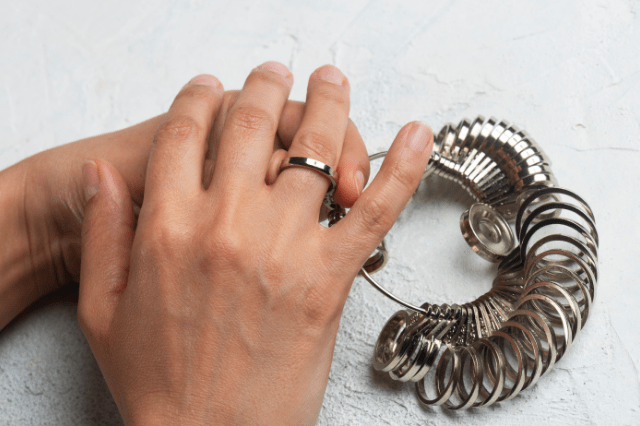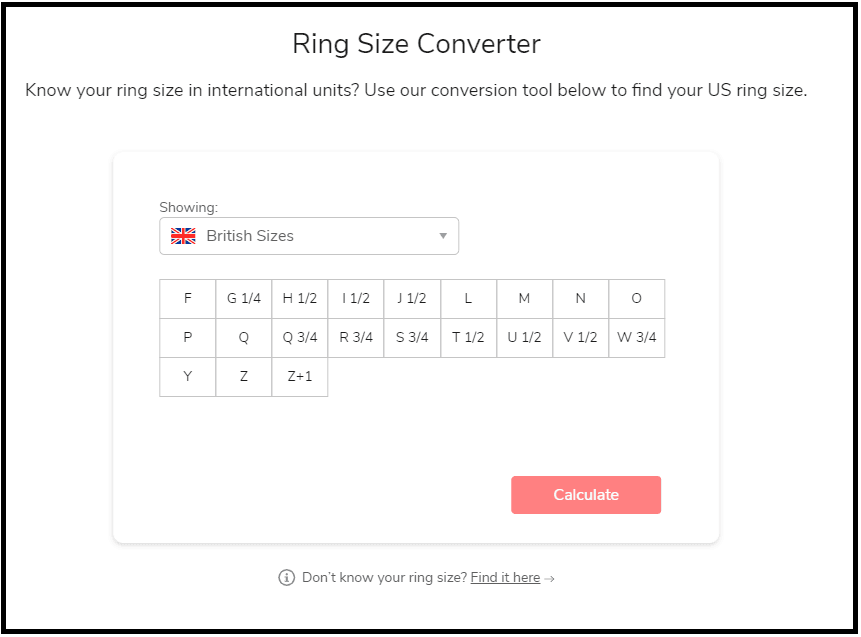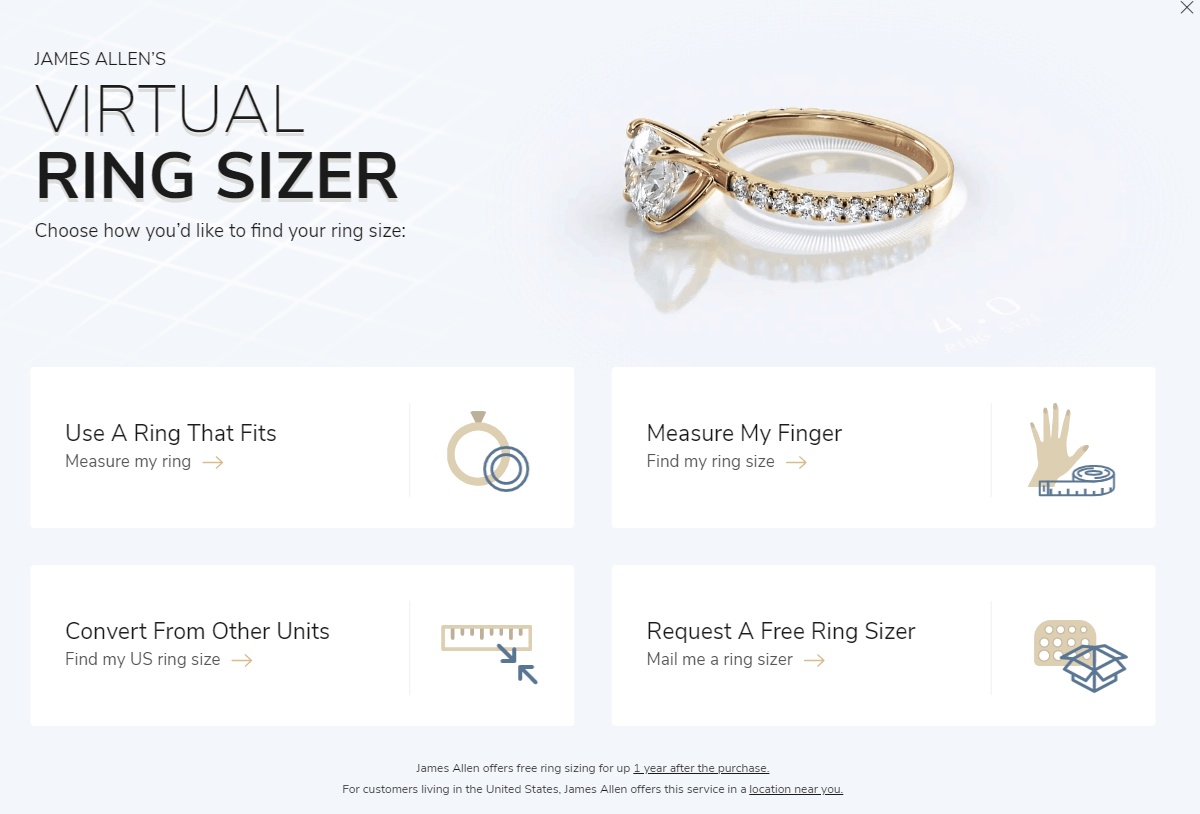
Table of Contents
There are multiple ring-size measurement systems used around the world, each with its pros and cons. Some systems, like the one used in Asia and South America, extend over large markets that have a low percent of consumer activity.
Others, like the one used in North America or in the UK, Australia, South Africa, and New Zealand, are used by smaller but highly active markets.
With the US and UK systems being two of the most prominent ring size systems out there, it’s worth exploring the comparison between them so that you can more easily jump from one to the other.
How Does the UK Ring Size System Work?

All ring size measurement systems around the world are numerical. But the system used in the UK, Australia, New Zealand, and South Africa being the only exception as it is alphabetical.
It has a total of 31 different scales that start from A and goes to Z in alphabetical order, then has the additional Z+2, Z+3, Z+4, Z+5, and Z+6 scales at the end.
There are also half grades and quarter grades, however, so you can often see ring size grades such as C 1/2, Q 3/4 or Z+1.5.

This screenshot shows the James Allen ring size converter page, which allows you to choose your ring measurement system when purchasing your ring.
Pros and Cons of the UK Ring Size System
The alphabetical order of the UK ring size systems sets it apart from all other systems which can be viewed as a positive. Alphabetical grades are also easier for people to remember.
There’s also an inherent simplicity in an alphabetical system because it’s intuitive and doesn’t confuse the consumer by mixing the grades with the actual mm or inch measurements of the rings.
On the other hand, that’s also one of the drawbacks of an alphabetical system – there’s no apparent logic to it unless you’ve already familiarized yourself with it. Numerical systems, on the other hand, can be more logical because it’s obvious how their grades are formed. In the German ring size system, for example, each size grade is simply equal to the inside diameter of the ring in millimeters.
So, a size 22 in the German system is a ring that has a 22mm internal diameter – as simple as that. The same ring will have a Z+1 size grade in the UK system, which can be very confusing for the consumer.
How Do the UK and the US Systems compare?
If you’re used to the US ring size system and you’re trying to figure out how the UK grades translate to the US measurements, here’s a chart to help you out. We’ve also included the inside diameter and inside circumference measures in both inches and millimeters.
| Inside Diameter | Inside Circumference | Sizes | |||
| MM | Inches | MM | Inches | UK & Australia | US & Canada |
| 9.91 | 0.390 | 31.13 | 1.22 | – | 0000 |
| 10.72 | 0.442 | 33.68 | 1.39 | – | 00 |
| 11.53 | 0.454 | 36.22 | 1.43 | – | 0 |
| 11.95 | 0.474 | 37.54 | 1.49 | A | 1/2 |
| 12.18 | 0.482 | 38.26 | 1.51 | A 1/2 | 3/4 |
| 12.37 | 0.487 | 38.86 | 1.53 | B | 1 |
| 12.60 | 0.496 | 39.58 | 1.56 | B 1/2 | 1 1/4 |
| 12.78 | 0.503 | 40.15 | 1.58 | C | 1 1/2 |
| 13.00 | 0.512 | 40.84 | 1.61 | C 1/2 | 1 3/4 |
| 13.21 | 0.520 | 41.50 | 1.63 | D | 2 |
| 13.41 | 0.528 | 42.13 | 1.66 | D 1/2 | 2 1/4 |
| 13.61 | 0.536 | 42.76 | 1.68 | E | 2 1/2 |
| 13.83 | 0.544 | 43.45 | 1.71 | E 1/2 | 2 3/4 |
| 14.05 | 0.553 | 44.14 | 1.74 | F | 3 |
| 14.15 | 0.557 | 44.45 | 1.75 | F 1/2 | 3 1/8 |
| 14.25 | 0.561 | 44.77 | 1.76 | F 3/4 | 3 1/4 |
| 14.36 | 0.565 | 45.11 | 1.77 | G | 3 3/8 |
| 14.45 | 0.569 | 45.40 | 1.79 | G 1/4 | 3 1/2 |
| 14.56 | 0.573 | 45.74 | 1.80 | G 1/2 | 3 5/8 |
| 14.65 | 0.577 | 46.02 | 1.81 | H | 3 3/4 |
| 14.86 | 0.585 | 46.68 | 1.84 | H 1/2 | 4 |
| 15.04 | 0.592 | 47.25 | 1.86 | I | 4 1/4 |
| 15.27 | 0.601 | 47.97 | 1.89 | I 1/2 | 4 1/2 |
| 15.40 | 0.606 | 48.38 | 1.90 | J | 4 5/8 |
| 15.53 | 0.611 | 48.79 | 1.92 | J 1/4 | 4 3/4 |
| 15.70 | 0.618 | 49.32 | 1.94 | J 1/2 | 5 |
| 15.80 | 0.622 | 49.64 | 1.95 | K | 5 1/8 |
| 15.90 | 0.626 | 49.95 | 1.97 | K 1/4 | 5 1/4 |
| 16.00 | 0.630 | 50.27 | 1.98 | K 1/2 | 5 3/8 |
| 16.10 | 0.634 | 50.58 | 1.99 | L | 5 1/2 |
| 16.30 | 0.642 | 51.21 | 2.02 | L 1/4 | 5 3/4 |
| 16.41 | 0.646 | 51.55 | 2.03 | L 1/2 | 5 7/8 |
| 16.51 | 0.650 | 51.87 | 2.04 | M | 6 |
| 16.71 | 0.658 | 52.50 | 2.07 | M 1/2 | 6 1/4 |
| 16.92 | 0.666 | 53.16 | 2.09 | N | 6 1/2 |
| 17.13 | 0.674 | 53.82 | 2.12 | N 1/2 | 6 3/4 |
| 17.35 | 0.683 | 54.51 | 2.15 | O | 7 |
| 17.45 | 0.687 | 54.82 | 2.16 | O 1/2 | 7 1/4 |
| 17.75 | 0.699 | 55.76 | 2.20 | P | 7 1/2 |
| 17.97 | 0.707 | 56.45 | 2.22 | P 1/2 | 7 3/4 |
| 18.19 | 0.716 | 57.15 | 2.25 | Q | 8 |
| 18.35 | 0.722 | 57.65 | 2.27 | Q 1/2 | 8 1/4 |
| 18.53 | 0.729 | 58.21 | 2.29 | Q 3/4 | 8 1/2 |
| 18.61 | 0.733 | 58.47 | 2.30 | R | 8 5/8 |
| 18.69 | 0.736 | 58.72 | 2.31 | R 1/4 | 8 3/4 |
| 18.80 | 0.740 | 59.06 | 2.32 | R 1/2 | 8 7/8 |
| 18.89 | 0.748 | 59.34 | 2.35 | R 3/4 | 9 |
| 19.10 | 0.752 | 60.00 | 2.36 | S | 9 1/8 |
| 19.22 | 0.757 | 60.38 | 2.38 | S 1/4 | 9 1/4 |
| 19.31 | 0.760 | 60.66 | 2.39 | S 1/2 | 9 3/8 |
| 19.41 | 0.764 | 60.98 | 2.40 | S 3/4 | 9 1/2 |
| 19.51 | 0.768 | 61.29 | 2.41 | T | 9 5/8 |
| 19.62 | 0.772 | 61.64 | 2.43 | T 1/4 | 9 3/4 |
| 19.84 | 0.781 | 62.33 | 2.45 | T 1/2 | 10 |
| 20.02 | 0.788 | 62.89 | 2.48 | U | 10 1/4 |
| 20.20 | 0.797 | 63.46 | 2.50 | U 1/2 | 10 1/2 |
| 20.32 | 0.800 | 63.84 | 2.51 | V | 10 5/8 |
| 20.44 | 0.805 | 64.21 | 2.53 | V 1/4 | 10 3/4 |
| 20.68 | 0.814 | 64.97 | 2.56 | V 1/2 | 11 |
| 20.76 | 0.817 | 65.22 | 2.57 | W | 11 1/8 |
| 20.85 | 0.821 | 65.50 | 2.58 | W 1/4 | 11 1/4 |
| 20.94 | 0.824 | 65.78 | 2.59 | W 1/2 | 11 3/8 |
| 21.08 | 0.830 | 66.22 | 2.61 | W 3/4 | 11 1/2 |
| 21.18 | 0.834 | 66.54 | 2.62 | X | 11 5/8 |
| 21.24 | 0.836 | 66.73 | 2.63 | X 1/4 | 11 3/4 |
| 21.30 | 0.839 | 66.92 | 2.64 | X 1/2 | 11 7/8 |
| 21.49 | 0.846 | 67.51 | 2.66 | Y | 12 |
| 21.69 | 0.854 | 68.14 | 2.68 | Y 1/2 | 12 1/4 |
| 21.89 | 0.862 | 68.77 | 2.71 | Z | 12 1/2 |
| 22.10 | 0.870 | 69.43 | 2.73 | Z +1/2 | 12 3/4 |
| 22.33 | 0.879 | 70.15 | 2.76 | Z+1 | 13 |
| 22.60 | 0.890 | 71.00 | 2.80 | Z+1.5 | 13.5 |
| 22.69 | 0.893 | 71.28 | 2.81 | Z+2 | – |
| 22.92 | 0.902 | 72.00 | 2.83 | Z+2.5 | – |
| 23.06 | 0.908 | 72.45 | 2.85 | Z+3 | – |
| 23.24 | 0.915 | 73.01 | 2.87 | Z+3.5 | – |
| 23.47 | 0.924 | 73.73 | 2.90 | Z+4 | – |
| 23.55 | 0.927 | 73.98 | 2.91 | Z+4.5 | – |
| 23.87 | 0.940 | 74.99 | 2.95 | Z+5 | – |
| 24.27 | 0.956 | 76.25 | 3.00 | Z+6 | – |
As you can see, both the US and the UK systems start from the same small ring size grade which is equal to 11.95mm or 0.474 inches in diameter. The UK system does reach higher grades with Z+6 going as large as 24.27mm in diameter, however, since the US system is numerical it can also be adapted to reach higher grades as well.
The alphabetical sizes and half sizes in the UK system can be confusing but the same can be said about the US system since there the size grades are connected to the mm/inch ring size in a rather convoluted way – each full-size increase is equal to a ~0.032 inch (0.8128 mm) increase in diameter or a ~1/10 inch increase in circumference.
Regardless, if you know your US ring size grade, with this chart you should be able to pretty easily determine your UK ring size.
Also, most retailers provide enough information to help you find the right ring size, as well as to convert between systems. For example, the screenshot taken below features several ways to measure your ring size as well as to convert from other sizing systems.

This takes a lot of the hassle and worry out of the buying process. And if you get your size wrong, most retailers will offer you one free ring sizing within a certain period. Always double check this, though, as some rings can’t be resized.
Other Ring Size Measurement Systems
There are several other major ring size grading systems in the world right now. One is used in most of Asia and South America, one is used in France and Russia, another is used in Germany (although Germany is also using the French system), and another is used in Switzerland, Italy, Span, the Netherlands, and several other European countries.
All these systems are numerical which can make it quite confusing for newcomers to distinguish and navigate between them.
- The German ring size system is quite easy to learn, as we mentioned above, as its grades are simply equal to rings’ internal diameters in mm.
- The French and Russian system is also easy as it’s based on the rings’ inside circumferences in millimeters. In other words, a ring with an internal circumference of 50mm will have a size grade of 50.
- The Swiss, Italian, and Spanish system is similar to that of France and Russia as it also uses the inside mm circumference for its grades but it extracts 40 from each size to arrive at its grade. So, that same 50mm ring from above which had a size grade of 50 in the French system would be a size 10 in the Swiss system.
- The Asian and South American system looks even simpler as it’s a straightforward numerical system that starts from 1, goes as high as 27 (the equivalent of Z+1 in the UK system), and doesn’t include any half-size grades. However, the lack of half sizes is generally viewed as a negative and this system’s grades aren’t directly tied to neither the diameter nor the circumference of the rings but are mostly arbitrary.
Wrapping Up
Finding your ring size can be one of the most challenging aspects of purchasing a ring. As always, check whether your ring can be resized and what the resizing costs are. If you’re ring ends up spinning on your finger, this article covers why this may be the case.









